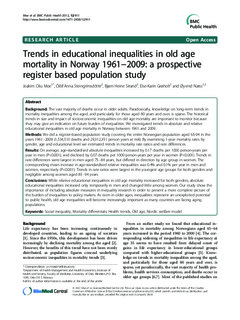| dc.description.abstract | Background The vast majority of deaths occur in older adults. Paradoxically, knowledge on long-term trends in mortality inequalities among the aged, and particularly for those aged 80 years and over, is sparse. The historical trends in size and impact of socioeconomic inequalities on old age mortality are important to monitor because they may give an indication on future burden of inequalities. We investigated trends in absolute and relative educational inequalities on old age mortality in Norway between 1961 and 2009. Methods We did a register-based population study covering the entire Norwegian population aged 65-94 in the years 1961-2009 (1,534,513 deaths and 29,312,351 person years at risk). By examining 1-year mortality rates by gender, age and educational level we estimated trends in mortality rate ratios and rate differences. Results On average, age-standardised absolute inequalities increased by 0.17 deaths per 1000 person-years per year in men (P<0.001), and declined by 0.07 deaths per 1000 person-years per year in women (P<0.001). Trends in rate differences were largest in men aged 75-84 years, but differed in direction by age group in women. The corresponding mean increase in age-standardised relative inequalities was 0.4% and 0.1% per year in men and women, respectively (P<0.001). Trends in rate ratios were largest in the youngest age groups for both genders and negligible among women aged 85-94 years. Conclusions While relative educational inequalities in old age mortality increased for both genders, absolute educational inequalities increased only temporarily in men and changed little among women. Our study show the importance of including absolute measures in inequality research in order to present a more complete picture of the burden of inequalities to policy makers. As even in older ages, inequalities represent an unexploited potential to public health, old age inequalities will become increasingly important as many countries are facing aging populations. | |
